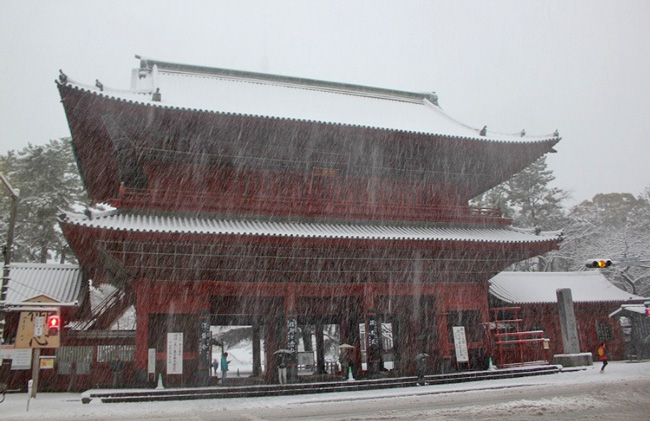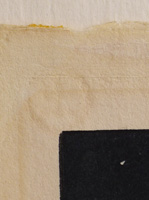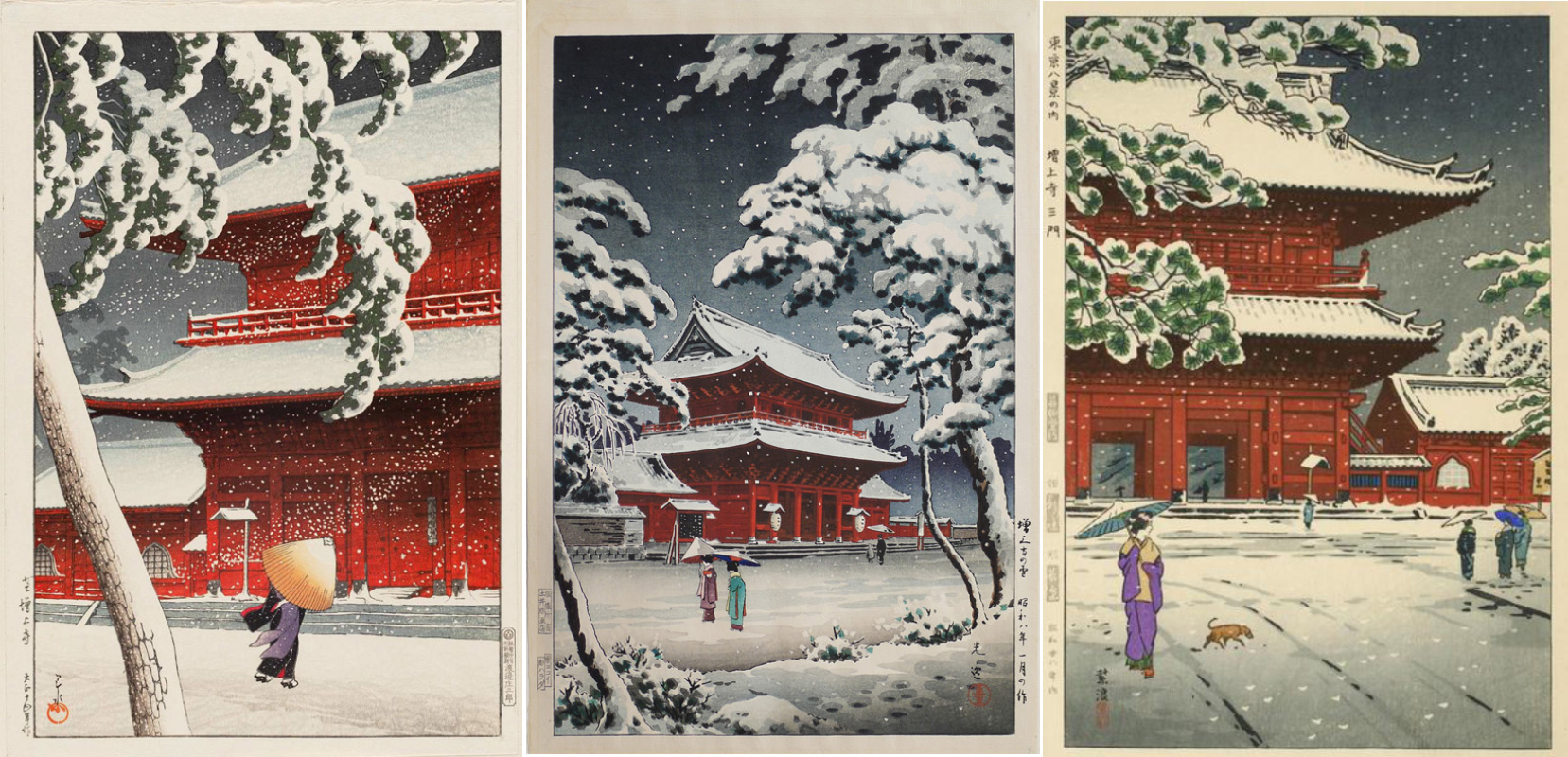About This Print
Tsuchiya Kōitsu
Zōjōji Temple in Snow, 1933
Zōjōji Temple History
Source: Zozoji website http://www.zojoji.or.jp/en/index.htmlZōjōji was founded in 1393 as an orthodox and fundamental nembutsu1 seminary for Jōdō shu2 in the Kanto (east Japan) region.
Zōjōji was relocated to the present site in 1598 after Ieyasu Tokugawa, founder of the Tokugawa shogunate, entered Edo (present-day Tokyo) in 1590 to establish his provincial government. After the start of the Edo Period when the Tokugawa shogunate ruled Japan, Zōjōji became the family temple of the Tokugawa family and an unparalleled grand cathedral was built. Zōjōji also served as an administrative center to govern the religious studies and activities of Jodo shu. In those days, its precincts covered an area of 826,000 square meters which also contained 48 smaller attached temples and about 150 grammar schools. Moreover, as many as 3,000 priests and novices always resided here as students.
Nevertheless, as the Tokugawa shogunate came to an end and the Meiji Era started, an anti-Buddhist movement got under way. The cathedral, temples and the mausoleum of the Tokugawa family were burned down by air raids during World War II. Thus, Zōjōji was profoundly affected by political and social circumstances. Today, however, its cathedral and other structures have been rebuilt, and Zōjōji continues to serve as the main temple of Jodo shu and the central nembutsu seminary for priests and novices. Furthermore, it has endeared itself to the general public as both a grand Buddhist temple typical of the metropolis Tokyo and a hub of religious and cultural activities.

1 The word literally means "buddha in mind" and it has come to mean verbal recitation of the words "I take refuge in Amitabha Buddha" in one language or another.
2 Jōdo shū (浄土宗, "The Pure Land School"), also known as Jodo Buddhism, is a branch of Pure Land Buddhism derived from the teachings of the Japanese ex-Tendai monk Hōnen. It was established in 1175 and is the most widely practiced branch of Buddhism in Japan, along with Jodo Shinshu.
Print Details
| IHL Catalog | #978 |
| Title | Zōjōji Temple in Snow (Zōjōji no yuki 増上寺の雪) |
| Series | originally released as part of the series Tokyo Views 東京風景 |
| Artist | Tsuchiya Kōitsu (1870-1949) |
| Signature |  |
| Seal | shinsei 真生 ("genuine") (see Signature above) |
| Publication Date | originally issued January 1933. This print is a later impression, produced after the artist's death. |
| Edition | post-WWII between 1950 and 1963 |
| Publisher |  Doi Hangaten - 土井版画店 Doi Hangaten - 土井版画店(family name Doi Eiiichi 土井英一) top seal: 版権所有 土井版画店 copyright reserved Doi Hangaten bottom seals: see Carver and Printer below[Koitsu.com reference K-34 seal 1950-1963] [Marks: pub. ref. 037; seal not shown] |
| Carver | Harada 彫 ハラダ (see publisher seal above - lower left cartouche) |
| Printer | Yokoi 摺 ヨコイ (see publisher seal above - lower right cartouche) |
| Impression | excellent |
| Colors | excellent |
| Condition | good - toning to verso |
| Miscellaneous |  Source: March 2000 interview by Andreas Grund with Mrs. Suzue Doi http://www.ukiyoe-gallery.com/doiinterview.htm Q.: Some prints carry a watermark, while others don't. What is behind this? A.: This depends on the paper. Sometimes we use paper with our "Do" watermark, sometimes we use plain paper. But even in case a watermark is on the paper, you should know, there is only a single watermark in the upper left corner of each sheet. The sheet, however, has double oban size and is cut half before printing. Consequently, one print gets the watermark, the other not. My printer always urges me, for cost reasons not to continue with the watermarked paper. |
| Genre | shin hanga (new prints) |
| Format | ōban tate-e |
| H x W Paper | 15 1/2 x 10 3/8 in. (39.4 x 26.4 cm) |
| H x W Image | 14 1/4 x 9 3/8 x in. (36.2 x 23.8 cm) |
| Collections This Print | |
| Reference Literature | The Catalogue Raisonne of Tsuchiya Koitsu Meiji to Shin-Hanga, Watercolours to Woodblocks, Ross F. Walker and Toshikazu Doi, Ohmi Gallery Publishing, 2009; Koitsu.com site reference TK-DH-001 |



